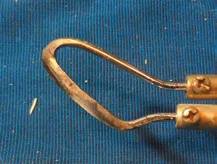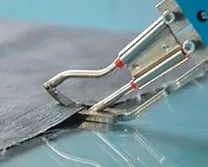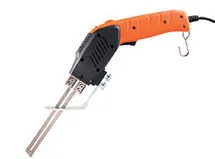You can cut cloth, carpet, and rope with scissors or a knife, but the result is a frayed mess, as soon as the item is put to use. There are reasons a sailmaker uses a hot-knife for most cuts and the chandlery bothers with fume control equipment, just so they can cut rope with a ribbon of hot steel. It works.
The Process
The right temperature is vital. Too hot and the blade wanders all over the place and makes a mess. Too cold and it must be forced, distorting the cut. Practice on a scrap.
Soldering Iron conversion
This discussion is based on a 150/230 watt soldering iron with a replaceable tip. The wattage is regulated by how far you pull the trigger. If the blade gets too hot, which will happen cutting single layers of cloth, just take your finger off the trigger for a few seconds now and then, or increase the diameter of the wire used to make the blade. Commercial hot knives are about 90 watts, so they are in the same basic range.
DIY blade. The thinner the wire, the higher the temperature. We’ve heard copper wire suggested, but it lacks sufficient strength once it gets hot. A mild steel wire, on the other hand, works fine. After experimenting with a number of gauges and wire types, we settled on a 0.13-inch diameter coat hanger as about perfect for our 150/230 watt soldering iron. For a different wattage, just keep the wire cross section proportional to the wattage. It does not need to be exact.
Form the wire as shown in photo #1 (adjacent page), leaving the legs long. Hammer the wire flat, tapering from ~ 1/32-inch on the edge to 1/16-inch along the spine. Smooth the sides and edge with a few strokes from a fine bastard file, creating a dull edge. Trim the legs to length and fit into the soldering iron.
Heat-Resistant Work Surface
Glass is often recommended for a work surface. It does not draw heat from the blade like metal, is smooth, and the melted cloth does not stick. In practice, I nearly always use metal, because it is portable and won’t break. The knife still slides smoothly, the cloth does not stick noticeably, and perhaps because of the over-sized soldering iron we use, we never notice the heat loss. We can insert a sheet between layers, protecting the fabric below. Plywood is OK, but it will get a lot of burn marks and add some smoke. Plastic will melt, and concrete is too rough.
Fabric. For fabric, the blade should be shaped something like an ice skate, with enough rocker to turn, but enough flat edge to track straight. It should not be sharp, but thin to an edge to about 1/32-inch thick; this will help it track straight and cut cleanly without excessive melting.
You should not feel the fabric drag against the blade. It should glide easily, the heat doing the work. But keep it moving at a steady pace or the melting will be excessive, the blade will wander, and it will smell as plastic builds up on the blade. Normally there is very little smell when cutting fabric, since the plastic does not build up on the blade.
Carpet. Cut carpet as you would fabric, but with more emphasis on keeping the knife moving. You do NOT need to linger to get good fusion; the thickness of the carpet virtually assures that. Do peel the cut portion away in an arc with your free hand, as though cutting thin metal with tin snips; this results in a smoother cut. It will smell, so work outside.
Rope. A straight blade is best, but the fabric blade will work just fine, particularly when cutting against a surface. For thick ropes, cut from both sides; it will be straighter and smoke less. Unlike the typical chandlery practice, we like to minimize the melted lump and apply a sailmaker’s whipping. Eventually a melted end can fray. On ropes over 3/8-inch in diameter, large melted lumps can crack, resulting in painfully sharp edges.
Bungee Cord. This really stinks, a consequence of melting the rubber core, but there is simply no other satisfactory way to cut and seal bungee cord. Whippings don’t hold and tape slides right off. A dip might work, but is doesn’t restrain the rubber core. For this reason, we melt bungee cord more generously than rope. Attachments are generally interchangeable between hot knife models and soldering guns.
Product reviews
DIY Blade. Hammered from a length of heavy wire coat hanger, it took us several generations to get it just right, but the result is versatile and durable.
Bottom line: This Budget Buy is enough for even serious DIYs.
Weller Hot Knife Blade
Cheap enough, but the straight shape and angle are all wrong for anything but cutting rope. $6.50.
Bottom line: Make your own.
HOT KNIVES
| MANUFACTURER | MODEL | POWER | COMMENTS | PRCE |
|---|---|---|---|---|
| HEATING ELEMENTS | ||||
| ENGEL HSGM | Hot knife | 90 watts | Hot knife | 190 |
| ROMECH $ | Hot knife | 100 watts | Hot knife | 65 |
| WELLER | Dual Heat 9400 OKS | 140/140 watts | Soldering iron | 38 |
| TIPS | ||||
| WELLER | RCT Tip | N/A | For cutting rope only | 6.5 |
| DIY TIP | DIY | N/A | Made from heavy wire | Free |





Weller Soldering Iron, Dual Heat 9400 PKS
This is just representative of the soldering gun class suitable for converting to a hot knife. With 100/140 watt capability, this will solder wires up to 8 AWG, and cut carpet, rope, and many layers of fabric with the hot knife attachment. Many brands are suitable and the elements are mostly interchangeable. Price is around $38.
Bottom Line: Recommended for hot knife and general soldering.
Engle HSGM Hot Knife
This 90-watt unit is the gold standard in hot knives, we’ve seen this model in most sail and canvas lofts. Perfect temperature control, better balance than a soldering iron, and it will outlive any DIY. Replacement blades and blades for cutting foam etc. are available. The cutting foot is particularly handy, allowing you to cut out windows and work around other fabric. About $190.
Bottom line: Best Choice.
RoMech Hot Knife
A less expensive alternative, and the sailors we talked to were quite satisfied. Often you can find it in a kit that includes a longer blade for cutting foam. 100 watts. Price is $65.
Bottom line: Best Value for the occasional user.
Conclusion.
The hot knife one of those tools you didn’t realize how much you needed, until you the first time you use it.
HSGM, www.sailrite.com
ROMECH, www.aleenes.com
WELLER, www.weller-tools.com



































Re: cutting carpet. It’d be good to say which surface of the carpet cuts best.
Hi Darrell,

the Url for Weller takes us to Alleenes….
I’ve used a wood burning tool for cutting fabric like Sunbrella.
Made one for my Sunbrella mainsail cover project. Works so great. Actually like doing on cardboard – slight fuse to surface so doesn’t move around, but releases with evidence. No smoke with 140 Watt Weller. Saved enough for a couple years subscription! Thanks Drew